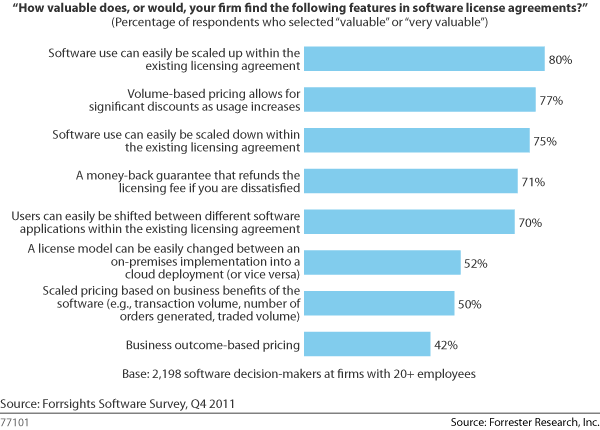SAP Seeks Director Of Pricing & Licensing – My Alternative Job Description
SAP is advertising for a new Director Of Pricing & Licensing. The job description states “The Strategic Pricing Director is a key member of SAP’s Revenue Strategy and Pricing Group. Pricing is a critical component of SAP’s overall strategy and go-to-market activities.” Duties include:
· Develop and implement pricing strategies based on economic and competitive dynamics.
· Price products and services appropriately based on the value customers receive.
· Define and drive pricing strategy for new and/or existing solutions.
IMO, SAP does many things very well in the pricing and licensing domain. I cite it to other publishers as an exemplar of best practices in a couple of areas, such as its pricing by user category, use of business metrics for parts of the suite that deliver value independent of manual use, and tying maintenance volume discounts to conditions such as centers of excellence that filter out users’ basic support calls. However, SAP does have room for improvement, in terms of Forrester’s five qualities of good software pricing, namely that it should be value-based, simple, fair, future-proof, and published.
Considering those goals, and as an advocate for software buyers, here are some things that I’d like SAP to add to the job description:
· Simplify pricing by eliminating 75% of the metrics used to license packages. SAP is one of the best in the industry at picking metrics that will “price products and services appropriately based on the value customers receive.” However, SAP packages a lot of functionality as extra modules that arguably should be enhancements within the standard product. Moreover, since each has its own licensing method, buyers face a complex portfolio of more metrics than they can understand or control. SAP could simplify its pricing significantly, by bundling more functionality into the basic license, and limiting product managers to a choice between a few simple permitted indicators of customers’ size and complexity.
· Change discounting policy to better reward loyalty and strategic commitment. SAP uses discounts to encourage customers to increase the size of each purchase. Sometimes this lures buyers into buying more users and products than they need, and/or can immediately implement. This boosts SAP’s short-term revenue but creates a shelfware mountain, from which “the value customers receive” is absolutely nothing and which is therefore causing growing customer resentment. Hopefully, “economic and competitive dynamics” will persuade it to change its discounting approach to one that rewards customers for their past loyalty and future strategic commitment to SAP, not merely for the size of the current deal.
· Update maintenance policies to offer cost flexibility. A recent Forrester survey found that over 70% of IT decision-makers want more licensing flexibility, to scale usage up or down, and stop paying for products they aren’t using (see Figure). The elastic commercial model is one of the drivers of the growth of SaaS. If SAP is to be a SaaS leader, as it hopes to be, then it will have to embrace this principle. SaaS vendors can’t charge customers for very long for products that don’t work, they haven’t implemented yet, have stopped using, or that are otherwise failing to deliver value.

Source: The New Software Paradigm: Buy-, Deploy-, And Pay-As-You-Like
In terms of culture, there seem to be two SAPs. On one side of its personality I meet bright, knowledgeable people who are committed to developing innovative products that will improve SAP’s customers’ businesses. From the darker side, I hear several terrifying stories from clients about SAP sales teams appearing to want to make their quarterly targets come what may, trying to extract money from customers on various tenuous grounds with no consideration of “the value customers receive.”
Bottom line: The new Director of Pricing and Licensing will have a particularly difficult job because he or she will sit like Janus between these two cultures, looking forwards at the product vision trying to charge customers for the value they receive, and backwards at the obsolete model that demands recognizable revenue, however obtained.
